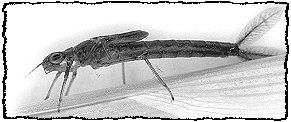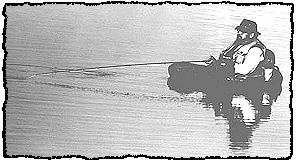Wet-fly techniques in lakes
By Clive Schaupmeyer
Adapted from "The Essential Guide to Fly-Fishing" by the author

The wet flies used on lakes imitate a host of insects and other
critters that are moving all the time. Some nymphs take rest breaks and
hold suspended from time to time, and of course stillwater aquatic insects
and other animals stay still when attached to vegetation. But generally,
they are a mobile lot and therefore most of the time when we fly-fish below
the surface in stillwater we retrieve the flies to imitate moving aquatic
critters. Most of the time.
�Assuming you know what fly to use there are two things you will
vary while fishing with wet flies in lakes: the depth the fly travels and
the retrieve.

Use a floating line, perhaps with split shot, or a sinking line
that takes your fly down to where the fish are. After casting let the fly
sink down for varying lengths of time or "countdowns" until you start hooking
fish. If you've been told the fish are near the bottom, or you suspect
they are, count how long it takes for the fly to snag on the bottom weeds.
Then on subsequent casts start retrieving a second or two sooner so your
fly travels just above the weeds.
Three things need to be varied in the retrieve: the speed of
each strip, the distance the fly travels each time and the interval between
strips. That's a lot of combinations and these can be further embellished
with twitches of the rod tip or small twitches with your rod-hand finger.
If you are not sure what retrieve method to use, start with something simple
and change from there. As mentioned in last week's article I've had the
most success retrieving wet flies in short 4- to 6-inch strips at about
1- to 2-second intervals. This retrieve has worked with marabou damselfly
imitations, Black Minks, leeches, Wooly Buggers and pike flies. And I've
caught trout, pike, bass and panfish with this retrieve. Sure other methods
work, but this is a good place to start if you don't have different information.
If this retrieve doesn't work, try some variations if there are
no other anglers around to ask or imitate. Try bringing the fly in slowly
using short, steady pulls on the line. Then try stripping faster and increase
the length of each strip. Perhaps let the fly sit or sink for a few seconds
between strips. Scuds are reported to shoot ahead and then suspend for
a few seconds to imitate the action of the natural bugs. It's worth a try
although the scuds I've watched in an aquarium and in local ponds never
seem to stop moving. If there are caddisflies emerging, try stripping a
sparkle caddis pupa fast to simulate a speeding adult heading for the surface.
Damselflies swim by undulating their bodies sideways in a willowy manner
like gators. Leeches swim fairly fast by undulating their bodies up and
down. Try to simulate the action of the naturals with your retrieve.

If you're nymph fishing and trout start rising, don't change
to a dry fly right away, especially if you've had some luck with the nymph
you have on. If you can figure out which direction a riser is moving, cast
10 or so feet ahead of the rise and retrieve the same as before assuming
that worked. If the trout is not locked onto some food type on the surface,
it may eat your wet fly even though it was taking dry flies at the moment.
Naturally, this works better with a floating line than a sinking line.
In addition to keeping the fly moving by casting and retrieving,
you also can troll a fly or troll and retrieve. These are good ways to
cover the water. If you hook a fish, make mental note of where you hooked
it, especially if the wind blows you some distance while landing the fish.
Then go back and fish the same area again. The fish you caught could have
been a random cruiser, but you may have found a popular hangout.
You can also drift fish. Start wherever you want the breeze to
take you and cast and retrieve as you drift along. Again, if you pick up
a fish or two, paddle back to the active area and try it again. If you
catch more fish on the second pass, change your tactic from drifting to
staying in one spot.
Most of the time you will keep your wet flies moving in lakes
by stripping in line or trolling. But wet flies like midge pupae can be
cast and allowed to sink with no retrieve.
This cast-sit-and-wait method is simple. A small pupa or other
wet fly is tied to a long leader (on a floating line), cast out, and left
to sink and then sit for several minutes. The line is watched closely and
any tugs on the line are responded to by lifting up the rod and tightening
the line.
I fished this way in a high lake years ago near Kamloops, British
Columbia, where the method is popular. I never did catch any of the large
Kamloops rainbows in that lake, but then again neither did any of the three
or four locals on the water who seemed to know what they were doing. Since
then, still fishing like this has worked for me a few times in ponds. However,
I've used a small strike indicator to keep the nymph just above the lake
or pond bottom. The floating indicator is also handy to detect strikes.
The most excitement that day came from shore, when a bear wandered
through a shoreline cattle camp. There was lots of shouting and dog barking.
That evening, while loading the boat on the top of my station wagon parked
in a dark, bushy isolated trail it occurred to me that I didn't know where
the bear had gone.
Closing message: Merry Christmas to fly anglers everywhere. Special
greetings to FAOL chat room friends from all over the world! Always respect
the fish you love so dearly. Dispatch them quickly or release them with
no harm. Be well in 1999. Cheers from Alberta, Canada.
~ Clive Schaupmeyer
Our Man In Canada Archives
|

 December 14th, 1998
December 14th, 1998




 December 14th, 1998
December 14th, 1998



